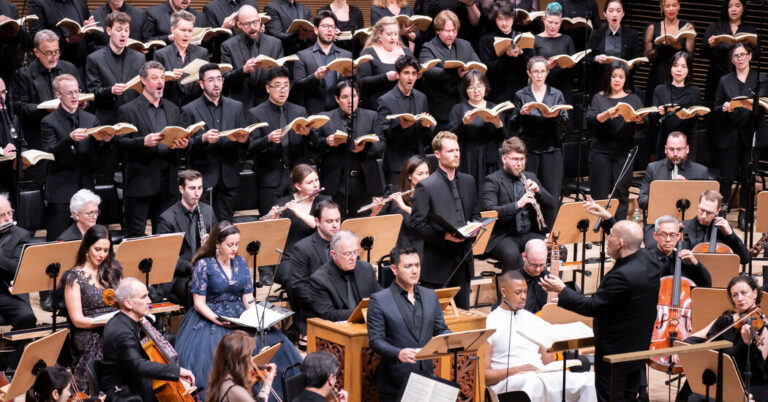
You could be forgiven, recently, for not remembering that Jaap van Zweden is the music director of the New York Philharmonic.
After he inaugurated the renovated David Geffen Hall in October, he disappeared from the orchestra’s performance calendar until a week ago. During that absence, the orchestra announced his successor, Gustavo Dudamel — whose visit to New York in February, to do little more than smile for the cameras and sign a piece of paper, was organized with so much fanfare, you almost felt bad for van Zweden, still the music director for one more season, as he quietly returned to the podium last Friday.
His current residency, though, while just two weeks, is hardly modest. On Tuesday, the Philharmonic announced his final season, in which he will lead eight subscription programs, including, as his farewell, Mahler’s colossal “Resurrection” Symphony. And for his concerts this time around — part of a barely advertised mini festival called “Spirit” — he has taken up a pair of monumental works: Messiaen’s “Turangalîla-Symphonie” and Bach’s “St. Matthew Passion.”
The Messiaen, sprawling and operatically excessive, would seem the better fit for van Zweden, who revels in enormity. But last week, it was mostly flattened and impatient, loud but not powerful.
And the Bach didn’t hold out much promise. Van Zweden has never had a true grasp of the fleet litheness of the Classical repertoire, almost never touches Baroque music with the Philharmonic. His performance of the “St. Matthew Passion” at Geffen Hall on Thursday, however, proved a pleasant surprise — perhaps his finest appearance this season.
More on N.Y.C. Theater, Music and Dance This Spring
After the thick bombast of the Messiaen, it was disorienting to hear van Zweden lead a “St. Matthew Passion” of wise, often deferential restraint and transparent, balanced counterpoint. The score’s nearly three hours of music moved along at a mostly unhurried pace, a calmly flowing mood set from the start: the opening chorus gently pulsating, the layers of sound smoothly accumulating.
Not that it was a consistently clean evening. The “Passion,” typically performed during the Lenten season but not limited to it, is a mammoth undertaking for double choir, double orchestra and soloists to recount the betrayal, death and burial of Christ. On Thursday, the Philharmonic — joined by Musica Sacra and the Brooklyn Youth Chorus — didn’t seem to have had enough time to prepare it.
Some sections unfurled without a fault; others were messy. Arias struggled to gain traction, and at times solo instrumentalists weren’t properly integrated with the larger ensemble. What’s lost, during lapses like that, are the moments that inspire awe, replaced by a kind of white-knuckle anxiety in, for example, the grand chorus that closes the oratorio’s first part.
But more memorable than those imperfections was van Zweden’s refreshingly measured treatment of the orchestra, particularly in its support for the vocal soloists.
And what soloists! The tenor Nicholas Phan was a lyrical, actorly guide through the story as the Evangelist, standing alongside the bass-baritone Davóne Tines’s Jesus, sung with a rich, creamy tone that, in Christ’s final words on the cross, turned compellingly momentous. The soprano Amanda Forsythe, her sound soaring and pure, shone in the longer, abstracted lines of the aria “Aus Liebe will mein Heiland sterben.” Tamara Mumford’s penetrating mezzo-soprano was well shaped in “Buss und Reu” and “Erbarme dich,” even at a nervously rushed tempo.
Each appearance by the tender, earnest tenor Paul Appleby felt too brief. In “Geduld,” as he sang alongside the viola da gamba player Matt Zucker — who, like the organist Kent Tritle, offered a dose of historically informed performance style — he spun trickily long melodic lines of complex rhythms so precisely articulated and elegant, you wished he would return to this piece as the Evangelist.
The standout was Philippe Sly, in his Philharmonic debut. This bass-baritone has a robust opera career — assured as either Leporello or the title character in Mozart’s “Don Giovanni” — and sang Jesus in a “St. Matthew Passion” with the Orchestra of St. Luke’s at Carnegie Hall last season. Commandingly resonant, but also sweetly warm in his upper range, he was more satisfying as a chameleonic soloists on Thursday: bringing dramatic color to the few lines of Judas, a desperate sadness to Peter and sensitivity to arias like “Komm, süsses Kreuz.”
His “Mache dich, mein Herze, rein,” already a high point of the score, was the high point of the concert, while also standing in for the evening as a whole. It had an unsteady start and could have been slower, yet once it found its footing, the aria was serene, balanced and — regardless of your faith or the time of year — profoundly moving.
New York Philharmonic
This program repeats through Saturday at David Geffen Hall, Manhattan; nyphil.org.